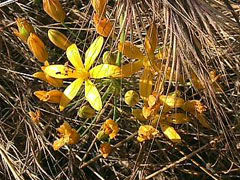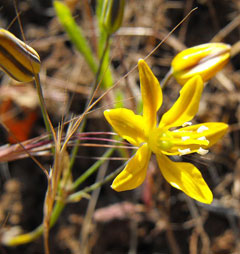 |
|
http://commons.wikimedia.org/wiki/User:Curtis_Clark |
 |
| http://commons.wikimedia.org/wiki/User:Stickpen |
Translate this page:
Summary
Physical Characteristics

 Bloomeria crocea is a BULB growing to 0.3 m (1ft) by 0.1 m (0ft 4in).
Bloomeria crocea is a BULB growing to 0.3 m (1ft) by 0.1 m (0ft 4in).
See above for USDA hardiness. It is hardy to UK zone 8. It is in flower from May to June. The species is hermaphrodite (has both male and female organs).
Suitable for: light (sandy) and medium (loamy) soils and prefers well-drained soil. Suitable pH: mildly acid, neutral and basic (mildly alkaline) soils. It cannot grow in the shade. It prefers moist soil.
UK Hardiness Map
US Hardiness Map
Synonyms
Nothoscordum aureum.
Plant Habitats
Cultivated Beds;
Edible Uses
Edible Parts: Root
Edible Uses:
Bulb[177]. It can be eaten raw at any time of the year[257].
References More on Edible Uses
Medicinal Uses
Plants For A Future can not take any responsibility for any adverse effects from the use of plants. Always seek advice from a professional before using a plant medicinally.
None known
References More on Medicinal Uses
The Bookshop: Edible Plant Books
Our Latest books on Perennial Plants For Food Forests and Permaculture Gardens in paperback or digital formats.

Edible Tropical Plants
Food Forest Plants for Hotter Conditions: 250+ Plants For Tropical Food Forests & Permaculture Gardens.
More

Edible Temperate Plants
Plants for Your Food Forest: 500 Plants for Temperate Food Forests & Permaculture Gardens.
More

More Books
PFAF have eight books available in paperback and digital formats. Browse the shop for more information.
Shop Now
Other Uses
The bulbs can be rubbed on metate into an adhesive and spread on seed gathering baskets to close the interstices[257]. No explanation is given of what metate is. There is a bamboo plant with this common name, but it is not native to America.
Special Uses
References More on Other Uses
Cultivation details
Requires a well-drained rich sandy loam and a warm position[1, 138]. Likes plenty of moisture when in growth[200], but plants should be kept quite dry from when the foliage dies down until the autumn[138]. This species is not hardy in the colder areas of the country, it tolerates temperatures down to between -5 and -10°c[200]. This genus is closely related to Brodiaea and Nothoscordum species[1, 200].
References Carbon Farming Information and Carbon Sequestration Information
Temperature Converter
Type a value in the Celsius field to convert the value to Fahrenheit:
Fahrenheit:
The PFAF Bookshop
Plants For A Future have a number of books available in paperback and digital form. Book titles include Edible Plants, Edible Perennials, Edible Trees,Edible Shrubs, Woodland Gardening, and Temperate Food Forest Plants. Our new book is Food Forest Plants For Hotter Conditions (Tropical and Sub-Tropical).
Shop Now
Plant Propagation
Seed - sow as soon as it is ripe or February/March in a well-drained compost in the greenhouse. Germination usually takes place within 1 - 3 months at 15°c[134]. Sow the seed thinly so that it can be grown on in the pot without disturbance for the first year, but apply an occasional liquid feed to ensure the plants do not become nutrient deficient. Pot up the small bulbs when they are dormant, putting 2 - 3 bulbs in each pot, and grow them on in a cold frame for another 2 years[134] before planting them out in the autumn when they are dormant. Division of flowering size offsets in the autumn. They are freely produced[200]. The larger bulbs can be planted straight out into their permanent positions if required, whilst it is best to pot up the smaller bulbs and grow them on for a year in a cold frame before planting them out in the autumn.
Other Names
If available other names are mentioned here
Native Range
NORTHERN AMERICA: United States (California)
Weed Potential
Right plant wrong place. We are currently updating this section.
Please note that a plant may be invasive in one area but may not in your area so it's worth checking.
Conservation Status
IUCN Red List of Threatened Plants Status :

Growth: S = slow M = medium F = fast. Soil: L = light (sandy) M = medium H = heavy (clay). pH: A = acid N = neutral B = basic (alkaline). Shade: F = full shade S = semi-shade N = no shade. Moisture: D = dry M = Moist We = wet Wa = water.
Now available:
Food Forest Plants for Mediterranean Conditions
350+ Perennial Plants For Mediterranean and Drier Food Forests and Permaculture Gardens.
[Paperback and eBook]
This is the third in Plants For A Future's series of plant guides for food forests tailored to
specific climate zones. Following volumes on temperate and tropical ecosystems, this book focuses
on species suited to Mediterranean conditions—regions with hot, dry summers and cool, wet winters,
often facing the added challenge of climate change.
Read More
Expert comment
Author
(Torr.)Coville.
Botanical References
71200
Links / References
For a list of references used on this page please go here
Readers comment